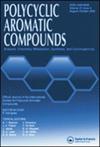1,2-二取代萘中芳香烃的光谱化学见解:使用1D和2D核磁共振光谱和x射线晶体学分析的研究
IF 2.6
3区 化学
Q2 CHEMISTRY, ORGANIC
引用次数: 0
摘要
萘及其衍生物通常被确定为环境污染的标志,尽管它们也被认为是许多有益化合物的重要组成部分。在本研究过程中,合成了一系列含硝基、胺基、磺酸基、氯基和羟基取代基的1,2-二取代萘,并利用FT-IR、1H NMR、13C NMR、DEPT-90、DEPT-135、DEPTq、元素分析和高分辨率质量(HRMs)等多种光谱技术对其进行了表征。这些化合物中芳香烃部分的核磁共振分析强调了取代基变化对1H和13C核磁共振信号的影响。为了解决一维(1D) 1H核磁共振信号重叠的问题,并确定芳香萘太基环上氢和碳原子的连通性,我们采用了“二维”实验,使用同核相关光谱(2D 1H-1H COSY)、异核单量子相关光谱(2D 1H- 13C HSQC)和异核多键相关光谱(2D 1H- 13C HMBC)。本工作还研究了1H NMR信号与薄层色谱(TLC)数据的相关性。x射线晶体学数据证实,与萘环不共面排列的特定基团的存在,与其他电子效应一起,对1H NMR信号的表现产生空间影响。这项研究将提供核磁共振数据,为萘衍生物在各种理论和实践领域的潜在应用和分析提供见解。本文章由计算机程序翻译,如有差异,请以英文原文为准。

Spectrochemical Insights into Aromatic Hydrocarbons in 1,2-Disubstituted Naphthalenes: Investigations Using 1D and 2D NMR Spectroscopy and X-Ray Crystallography Analysis
Naphthalene and its derivatives are often determined as markers of environmental pollution, although they are also recognized as crucial building blocks in many beneficial compounds. In the course of this study, a range of 1,2-disubstituted naphthalenes bearing nitro, amine, sulfonate, chlorine, and hydroxyl substituents were synthesized and characterized using several spectroscopic techniques, including FT-IR,1H NMR,13C NMR, DEPT-90, DEPT-135, DEPTq, elemental analysis, and high-resolution mass (HRMs). The NMR analysis of the aromatic hydrocarbon moiety in these compounds emphasized the impact of substituent variations on the appearance of 1H and 13C NMR signals. To resolve the issue of overlapping one-dimensional (1D) 1H NMR signals and determine the connectivity of hydrogen and carbon atoms from the aromatic naphtayl ring, we employed a “two-dimensional” experiment, using homonuclear correlation spectroscopy (2D 1H-1H COSY) and heteronuclear single quantum correlation (2D 1H - 13C HSQC) and heteronuclear multiple‐bond correlation spectroscopy (2D 1H - 13C HMBC). This work also investigated the correlation between 1H NMR signals and thin-layer chromatography (TLC) data. X-ray crystallography data validates that the presence of a specific group, not aligned coplanarly with the naphthyl ring, exerts a spatial influence on the manifestation of 1H NMR signals, alongside other electronic effects. This study will offer NMR data, providing insights into the potential applications and analyses of naphthalene derivatives across various theoretical and practical domains.
求助全文
通过发布文献求助,成功后即可免费获取论文全文。
去求助
来源期刊

Polycyclic Aromatic Compounds
化学-有机化学
CiteScore
3.70
自引率
20.80%
发文量
412
审稿时长
3 months
期刊介绍:
The purpose of Polycyclic Aromatic Compounds is to provide an international and interdisciplinary forum for all aspects of research related to polycyclic aromatic compounds (PAC). Topics range from fundamental research in chemistry (including synthetic and theoretical chemistry) and physics (including astrophysics), as well as thermodynamics, spectroscopy, analytical methods, and biology to applied studies in environmental science, biochemistry, toxicology, and industry. Polycyclic Aromatic Compounds has an outstanding Editorial Board and offers a rapid and efficient peer review process, as well as a flexible open access policy.
 求助内容:
求助内容: 应助结果提醒方式:
应助结果提醒方式:


